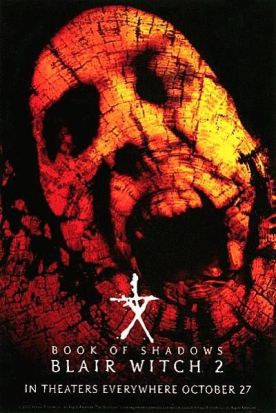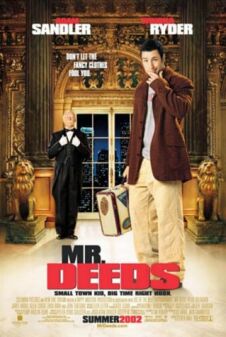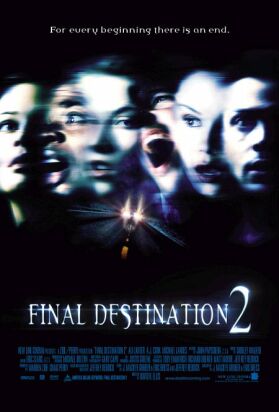Book of Shadows: Blair Witch 2
The iron rule in Hollywood is that if you’ve got a hit, you’ve got to have a sequel. But what happens when the hit depends, as last year’s Blair Witch Project did, on a necessarily temporary illusion of reality? Fool me once and I’ll give you a good review; fool me twice and I’m an idiot. The original writer/directors, Daniel Myrick and Eduardo Sánchez, have now become producers of the sequel, Book of Shadows: Blair Witch 2, which is directed by Joe Berlinger. Berlinger is best known for a real documentary involving charges of witchcraft, Paradise Lost: The Child Murders at Robin Hood Hill of 1996, and he decides to give the fake documentary one more try, cleverly building on the effectiveness of the illusion of the original by making his characters a local kid from Burkittsville, Maryland and the out-of-state movie fans who pay him to take them around the sites depicted in the film.
But why should the film attempt a trick that it must know it can’t hope to get away with a second time? The printed announcement on the screen—that “This is a fictionalized re-enactment of events that occurred in the aftermath of The Blair Witch Project”—is an obvious cop-out. What has The Blair Witch Project franchise got to do with “fictionalised” ? Still, he goes through the motions of giving us a second attempt at creating the illusion of real life and real horror, beginning with people said to be Burkittsville residents being interviewed about the impact of the film on their neighborhood. Among these is the exasperated local sheriff (as we are told) Ronald Cravens (Lanny Flaherty), who looks like the late Slim Pickens and is seen shouting at some of the tourists and sensation-seekers who descended on the town: “Get out of these woods and go home! There is no goddamn Blair Witch!”
The sheriff is the only one of the main characters who acknowledges being an actor by having a different name from his character’s. As in the original, the young witch-victims have the same name as the actors who play them—or almost the same name in the case of one of them who is listed on the cast list as “Tristine” but who in the film is called Tristen. One of the locals who is interviewed in the opening sequence is the troubled youth Jeff (Jeff Donovan) who is not unknown to the Sheriff and local juvenile courts and who has spent some time in a mental hospital. He proposes to take some other kids, Blair Witch Project fans from Massachusetts, into the woods. Jeff, speaking to the camera, claims to have seen the movie seventeen times and to believe that witch is real. How does he know? “I know, man. I know.”
Berlinger is thus attempting to hang on to the illusion of reality without having to live or die by it. As in the original, the actors are given an array of cameras and other recording devices in order, supposedly, to account for the film footage we are seeing, but Blair Witch type striving after complete verisimilitude is soon forgotten. Instead the film veers off into a more traditional sort of horror movie with the silly, adolescent theme implied by questioning whether the “real” world is what we actually experience or what we see on the video afterwards. Deep, man. Not too surprisingly, the video tells a different and more horrifying story from what the film leads you to believe actually happened—and, of course, the powers that be believe the video. That’s evidence.
Did the Blair Witch mess with this record of reality, or are the terrified youngsters (again like the original, the bewitched are all aged roughly 19 to 24) suffering from some kind of collective hysteria? Well, nobody ever went broke in Hollywood catering to paranoid delusions, and Berlinger may have salvaged enough of an audience among the young, impressionable fans of the original BWP at least to break even. As if to emphasize the age of the audience he is aiming at, he makes the film in the style of a music video as well, with quick cutting away from the main narrative line to anonymous images of people being stabbed, bound, hanged, or disembowled. Perhaps we, too, have to decide between the reality of film and video footage. Heavy!
There are a couple of good things. One of the out-of-staters who comes to see the Blair Witch sites is a self-proclaimed “Wiccan” called Erica (Erica Leerhsen) who gets some funny lines in the course of attempting to argue that witches are really good and benevolent. “We’ve always been misunderstood,” she says. “We embrace nature, not evil.” Later, when a television announcer speculates that some murders in the woods were connected with the legendary local witch, Erica says disgustedly: “It’s the great American pastime: blame it on a witch.” I’m happy to say that she comes to a gruesome end. The other amusing bit is when, after the video butchery inspires a TV news report, the announcer intones: “Sadly, as so many times before in this country, screen violence has inspired real life violence.” It’s a good joke, but on the whole I don’t think there is enough in this movie to interest a grown-up.
Discover more from James Bowman
Subscribe to get the latest posts to your email.






